Related Research Articles
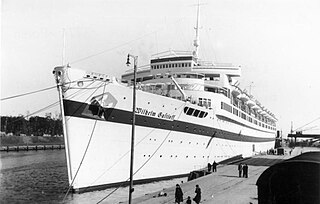
MV Wilhelm Gustloff was a German military transport ship which was sunk on 30 January 1945 by Soviet submarine S-13 in the Baltic Sea while evacuating civilians and military personnel from East Prussia and the German-occupied Baltic states, and German military personnel from Gotenhafen (Gdynia), as the Red Army advanced. By one estimate, 9,400 people died, making it the largest loss of life in a single ship sinking in history.
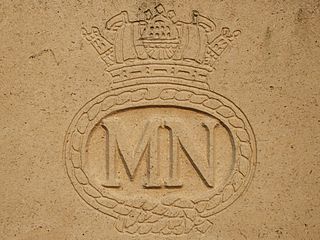
The British Merchant Navy is the collective name given to British civilian ships and their associated crews, including officers and ratings. In the UK, it is simply referred to as the Merchant Navy or MN. Merchant Navy vessels fly the Red Ensign and the ships and crew are regulated by the Maritime and Coastguard Agency (MCA), a specialist agency of the UK Department of Transport. British merchant ships are registered under the UK or Red Ensign group ship registries. British Merchant Navy deck officers and ratings are certificated and trained according to STCW Convention and the syllabus of the Merchant Navy Training Board in maritime colleges and other training institutes around the UK.

The Soviet Navy was the naval warfare uniform service branch of the Soviet Armed Forces. Often referred to as the Red Fleet, the Soviet Navy made up a large part of the Soviet Union's strategic planning in the event of a conflict with the opposing superpower, the United States, during the Cold War (1945–1991). The Soviet Navy played a large role during the Cold War, either confronting the North Atlantic Treaty Organization in western Europe or power projection to maintain its sphere of influence in eastern Europe.

K-56 was a Project 675 nuclear submarine of the Soviet Navy.

Mamert Stankiewicz was a Polish naval officer of the merchant marine, the commander of Lwów, Polonia and finally captain of the Polish ocean liner Piłsudski, which was incorporated into the UK Royal Navy and converted into the ship transporting British and Polish soldiers during World War II. On 26 November 1939, Pilsudski was torpedoed by German U-boat, and Stankiewicz, after inspecting the entire sinking ship to ensure that there were no sailors and soldiers left behind, and after rescuing sailors and soldiers from the ice-cold Northern Atlantic, died of exhaustion. Stankiewicz's life was immortalized by Karol Olgierd Borchardt, whose series of books on Stankiewicz became a best-seller among Polish maritime books.
The Baltic Sea Shipping Company or B.S.S.C is a Russian sea transport engaged in the business of oil products storage via rail wagons within Russian link-able terminals, and tanker ship along the inland waterways and coastal seas of European Russia. The company is headquartered in Saint Petersburg and operates in the Baltic Sea. It was founded in 1835. In the Soviet Union it was the largest steamship company with about two hundred registered vessels. In November 1992, it was transformed into a joint stock company.

The icebreaker Fyodor Litke was active in the Soviet era in the Arctic, until the late 1950s. It was built in 1909 in England for the Saint Lawrence River service and initially named CGC Earl Grey after Albert Grey, Governor General of Canada. After four years in Canada it was sold to the Russian government and eventually renamed Fyodor Litke in honour of the Arctic explorer Fyodor Petrovich Litke.

SS Stalingrad was a steamship of the Soviet Union, named after the Soviet city of Stalingrad, itself named after Joseph Stalin. She was built at Soviet Shipyard No. 189 (Ordzhonikidze) in Leningrad and operated by Chief Directorate of the Northern Sea Route (GUSMP), who homeported her in Vladivostok. She had entered service in 1933.

Poltava (Полтава) was the second of the Gangut-class battleships of the Imperial Russian Navy built before World War I. The Ganguts were the first class of Russian dreadnoughts. She was named after the Russian victory over Charles XII of Sweden in the Battle of Poltava in 1709. She was completed during the winter of 1914–1915, but was not ready for combat until mid-1915. Her role was to defend the mouth of the Gulf of Finland against the Germans, who never tried to enter, so she spent her time training and providing cover for mine laying operations. She was laid up in 1918 for lack of trained crew and suffered a devastating fire the following year that almost gutted her. Many proposals were made to reconstruct or modernize her in different ways for the next twenty years, but none were carried out. While all this was being discussed she served as a source of spare parts for her sister ships and was used as a barracks ship. She was finally struck from the Navy List in 1940 and scrapping began at a very leisurely rate. She was intentionally grounded in late 1941 to prevent her from being sunk in some inconvenient location by the Germans. She was refloated in 1944 and scrapped beginning in 1949.

The Peter the Great Naval Corps - Saint Petersburg Naval Institute, formerly known as the M. V. Frunze Higher Naval School, is the oldest of the Russian Navy's naval officer commissioning schools. It is located in Saint Petersburg.
Heinrich Arp was a 1,428 GRT cargo ship that was built in 1923 by shipyard F Schichau, Elbling, Weimar Republic for German owners «Heinrich F C Arp», Hamburg. In May 1945, she was seized by the Allies at Hamburg, passed to the Ministry of War Transport (MoWT) and renamed Empire Connemara. In May 1946, she was transferred to the Soviet Union and renamed Liza Chaikina.

A/S Merilaid & Co. was an Estonian shipping company. The firm was founded in Tallinn, Estonia on 18 February 1930. There were seven founding shareholders, most of whom were related by blood or marriage as descendants of Peeter All. Of the 7 founders, 6 were ship captains and 5 had worked in the Far East, in Vladivostok and/or Shanghai, for many years, and had avoided the turmoil of the Bolshevik or Communist Revolution, prior to returning home to a free Estonia. Estonia had been part of the Russian Empire since 1721 when Russia defeated Sweden in the Great Northern War. After World War I, and concurrent with the Russian Civil War, Estonia defeated Russia in the 1918–1920 War of Independence and became an autonomous nation after almost 200 years of Russian rule.
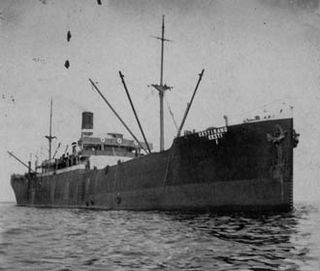
SS Eestirand, built in 1910, was an Estonian steel-hulled cargo steamship. She was one of the largest ships in her class at the time and served as the mother-ship of the first Estonian herring expeditions in the 1930s. After Estonia was occupied by the Soviet Union in 1940, she was used as a Soviet Navy transport vessel in World War II until beached in 1941 on Prangli Island during the Soviet evacuation of Tallinn.

SS Ashkhabad was a merchant ship of the Soviet Union sunk in 1942. She had been built as a British merchant ship in 1917 in Glasgow, Scotland as War Hostage. Over the next three decades she passed through a number of owners and had several different names; Milazzo (1919–1924), Aldersgate (1924–1925), Mistley Hall (1925–1934), Kutais (1934–1935), Dneprostroi (1935–1938) and finally Ashkhabad from 1938 to 1942. Originally designed as a freighter, she was at several points converted to a tanker to carry fuel oil. At the time of her loss the four hundred foot tanker was owned by the Soviet Union's Sovtorgflot organisation. She was torpedoed on 29 April 1942, and then sunk as a hazard to navigation on 3 May 1942. The wreck is now a popular dive site.
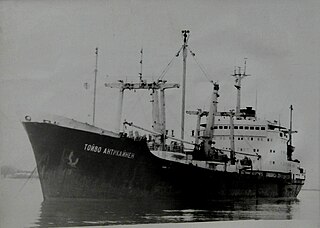
Toyvo Antikaynen was a merchant ship of Black Sea Shipping Company, tweendecker type general cargo ship, project B401. This ship is one of the Kommunist-class cargo ships. The ship was named in honor of the Finnish communist leader and the Red Army officer Toivo Antikainen.

Marshal Voroshilov was a Project 1134A Berkut A class cruiser of the Soviet Navy, which briefly became part of the Russian Navy after being renamed Khabarovsk in 1991. The fifth ship of her class, the ship served mostly during the Cold War, from 1973 to 1992.

Admiral Oktyabrsky was a Project 1134A Berkut A -class cruiser of the Soviet Navy, which briefly became part of the Russian Navy. The sixth ship of her class, the ship served mostly during the Cold War, from 1973 to 1993.
Yuri Aleksandrovich Panteleyev was an officer of the Soviet Navy. He rose to the rank of admiral and was commander of the Pacific Fleet.

The Makarov Pacific Higher Naval School is one of the Russian Navy's two higher educational institutions under the Ministry of Defense of Russia, with this school being located in Vladivostok in Eastern Russia, the only naval educational institution in this region. It serves as an naval officer commissioning school for officers in the Pacific Fleet. It is named after the accomplished Russian oceanographer and commander of the Imperial Russian Navy, Vice-Admiral Stepan Makarov.
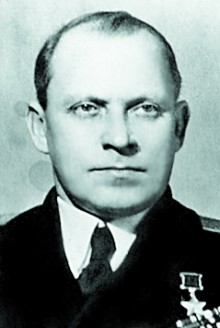
Neon Vasilyevich Antonov was a Soviet Navy Rear Admiral and recipient of the title of Hero of the Soviet Union, during World War II.